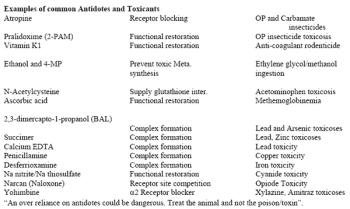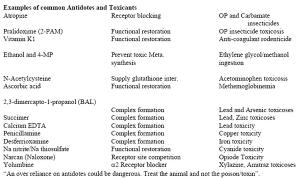
Lead-based paints, lead-based gasoline, solder, combustion residues, caulking compounds, improperly glazed pottery, batteries, buck-shots, sewage sludge, some canned commercial dog foods, electronic wastes, etc.

Lead-based paints, lead-based gasoline, solder, combustion residues, caulking compounds, improperly glazed pottery, batteries, buck-shots, sewage sludge, some canned commercial dog foods, electronic wastes, etc.

The gastrointestinal tract is the primary route of exposure. Ethylene glycol is a small molecule (62 dalton) which undergoes rapid absorption from the gastrointestinal tract, distributes to the liver where it is rapidly metabolized by the hepatic alcohol dehydrogenase pathway to toxic metabolites (glycoaldehyde, glycolic acid, glyoxlic acid, oxalic acid, and formic acid), and is excreted in the urine. These metabolic intermediates (organic acids) induce severe metabolic acidosis, kidney failure and subsequent death, in exposed animals and humans.

Oral exposure to toxicants among small animals (pets) is the most common. Biological activities are graded, and, are based on toxicants reaching their sites of action (effectors) in biological system at a sufficient concentration and duration. Intensity of a biological effect is dose related. Basic pharmacokinetic/toxicokinetic principles of toxicants become essential in addressing toxicity. Toxicant concentrations at effector sites are based on absorption, distribution, metabolism, and excretion of individual toxicants.

Agents (physical, chemical or biological) designed to kill pests that interfere with the comfort, health or economic wellbeing of man. Accompanying their beneficial effects, illnesses and deaths in man and animal alike, have been reported. Recorded use of compounds in the control of pests goes back to 1000 BC, when sulfur was used for such purpose. Since then their have been continued development of more effective and safe pesticides. Currently in use today are > 600 pesticides, constituting 15,000 compounds in 3,500 formulations.

Pets' eating and grooming habits, species inherent sensitivities to certain chemical/foods, and owners' attitudes are helpful in preventing accidental exposures. Similar hand-to-mouth behavior observed in children is the expected with pets. All precautions – properly store all hazardous chemicals, personal human medication, read medication labels, and know the need for, and seek immediate veterinary care - should be taken in preventing access of pet to hazardous substances.

A lingering human impression that most synthetic chemicals/compounds are unsafe and those of natural origin are safe remains un-substantiated. Of an estimated 30,000 plant species (wild and cultivated) found in North America, approximately 700 species have been reported toxic to animals. These plants are toxic on account of chemicals found in them, which are toxic to animals on ingestions. These components (alkaloids, glycosides, phenols, phyto estrogens, resins etc.) are structurally and functionally diverse.

Species of poisonous snakes found in North Carolina - Pit Vipers (Copperhead (Agkistrodon contortrix), Cottonmouth (Agkistrodon piscivorous. Timber Rattlesnake (Crotalus horridus, Eastern diamondback rattlesnake (Crotalus adamanteus, Pygmy rattlesnake (Sistrurus miliarius), Elapidae Eastern coral snake (Micrurus fulvius fulvius).

Published: August 1st 2010 | Updated:

Published: August 1st 2010 | Updated:

Published: August 1st 2010 | Updated:

Published: August 1st 2010 | Updated:

Published: August 1st 2010 | Updated:

Published: August 1st 2010 | Updated: